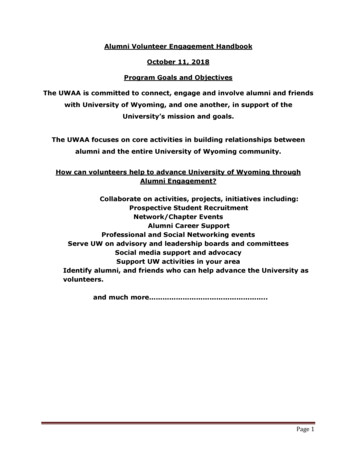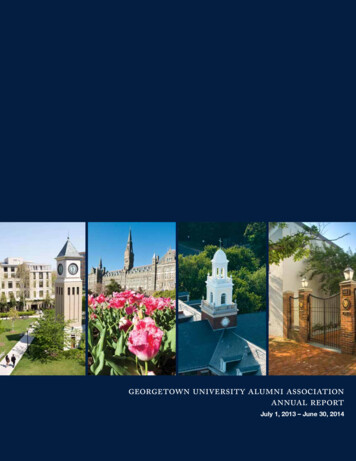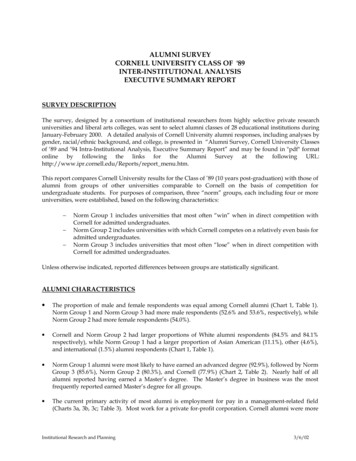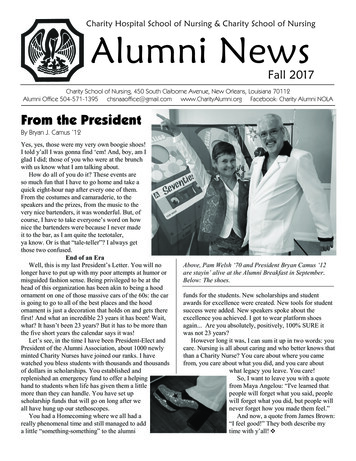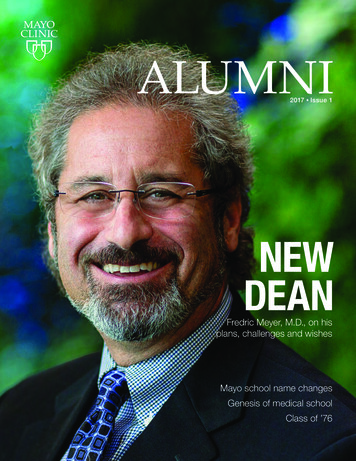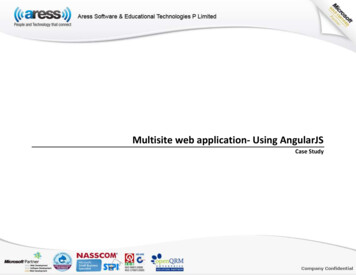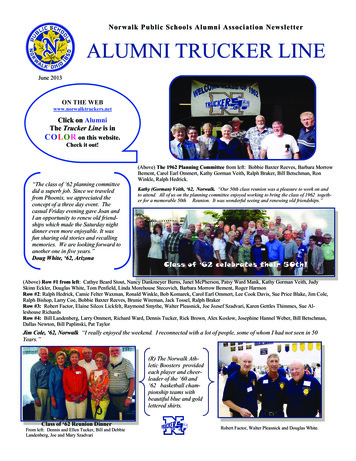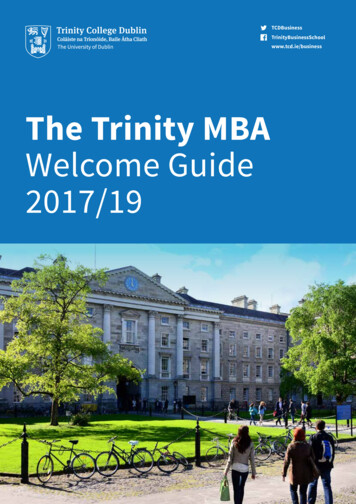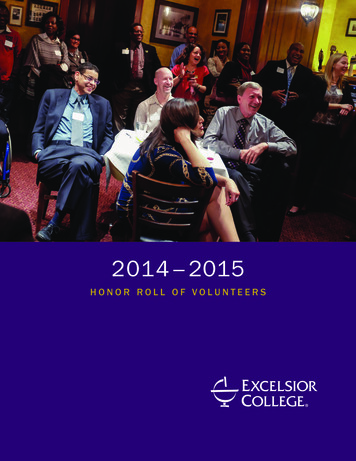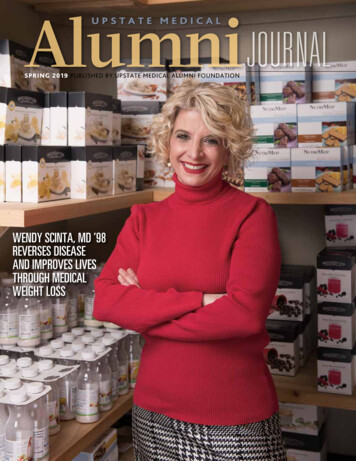
Transcription
Alumni JOURNALUPSTATE MEDICALSPRING 2019 PUBLISHED BY UPSTATE MEDICAL ALUMNI FOUNDATIONWENDY SCINTA, MD ’98REVERSES DISEASEAND IMPROVES LIVESTHROUGH MEDICALWEIGHT LOSS
M ED I C A L A L U M NIB O A R D O F D I R EC T O R SDennis D. Daly, MD ’83EMERITUS810PresidentRobert A. Dracker, MD ’82Vice PresidentLarry S. Charlamb, MD ’88TreasurerBarbara A. Morisseau, MD ’98SecretaryThomas A. Bersani, MD ’82Richard M. Cantor, MD ’76Mantosh Dewan, MDRichard W. DoustMark S. Erlebacher, MD ’79Brian J. Gaffney, MD ’72Diane F. Green-el, MD ’78Douglas W. Halliday, MD ’79Ruth H. Hart, MD ’80Karen K. Heitzman, MD ’83Robert H. Hill, III, MD ’06Danielle A. Katz, MD ’97Jeffrey R. LaDuca, MD ’98Bruce M. Leslie, MD ’78Charles J. Lutz, MD ’93Kirsten P. Magowan, MD ’87Mark S. Persky, MD ’72Amy L. Reynders, MD ’01Charles J. Ryan III, MD ’82K. Bruce Simmons, MD ’79Ralph L. Stevens, MD ’81James A. Terzian, MD ’75A. Geno AndreattaFrederick R. Davey, MD ’64E. Robert Heitzman, MD ’51Patricia J. Numann, MD ’65Michael H. Ratner, MD ’68Gregory A. Threatte, MD ’73Jack Yoffa, MD ’69EX-OFFICIOJulio Licinio, MD, PhDChristopher Morley, PhD,MA, CASPaul NorcrossJulie White, PhDHONORARYSadri GarakaniSTUDENTREPRESENTATIVESDaniel Kaufman ’19BinghamtonKatie Rong ’19Michael DePasquale ’20Elisabeth Sulger 20BinghamtonAmanda Balch ’21Tyler Fuller ’22AlumniJOURNALUPSTATE MEDICAL1418Features8The Teaching PhysicalHoward Weinberger, MD ’58, shares his most intimate anatomy lesson.10Doctoring Tomorrow’s DoctorsJarrod Bagatell, MD ’93, provides a current perspective on Student Health Services.14Published by the UpstateMedical Alumni Foundation of Upstate MedicalUniversity, Setnor AcademicBuilding #1510, 750 E. AdamsSt., Syracuse, New York13210-9976Issue Number: 76The Obesity BusterWendy Scinta, MD ’98, helps patients reverse disease and improve lives through weight loss.18The Story Behind Dora’s DreamA relationship between medical student and patient leads to a lifelong friendship.Departments1202231SPRING 2019 ISSUEPublished three times in 2019in spring, autumn, and winter.Copyright 2019 by UpstateMedical Alumni Foundation.Opinions expressed are thoseof the individual authors andsubjects and do not necessarily reflect the views of theAlumni Foundation or UpstateMedical University.COURTYARDSTUDENT ROUNDSCLASS NOTESIN MEMORIAMSubmissions and addresscorrections should be sent toPaul Norcross, SUNY UpstateMedical University, SetnorAcademic Building #1510,750 E. Adams St., Syracuse,New York 13210-9976Phone: 315/464-4361Fax: 315/464-4360Email:norcrosp@upstate.eduPaul NorcrossExecutive EditorRenée Gearhart LevyManaging EditorSarah BurnsAmy Edmond-DrapasLori MurphyChere RavenContributing EditorsKiefer CreativeDesign and ProductionKathleen Pace FroioDarryl GeddesEmily KulkusWendy Scinta, MD, ’98Howard Weinberger, MD ’58Contributing WritersSusan KahnWilliam MuellerDebbie RexineRich WhelskyPhotographersMichael H. Ratner, MD ’68,ChairThomas Bersani, MD ’82Fred Davey, MD ’64Diane Green-el, MD ’78Ruth Hart, MD ’80James Terzian, MD ’75Editorial BoardJUST A CLICK AWAYVisit the Medical Alumni webpage at medalumni.upstate.edu for special eventinformation, past AlumniJournals, givingopportunities, and more.Follow us on Facebook atwww.facebook.com/UpstateMedicalAlumniON THE COVER: Wendy Scinta, MD ’98,pictured at her office inFayetteville, New York.
C O U R T YA R DUpstate Launches FamilyMedicine ResidencyUpstate Medical Universityis collaborating with theSyracuse Veteran’s Adminis tration Medical Center to launcha new family medicine residencyprogram, the first for Upstate.The three-year program will beginin July and has already attractedtremendous interest.According to Program DirectorR. Eugene Bailey, MD ’89, theprogram received 400 applicationsfor the six spots in its inaugural year.Program administrators conductedmore than 70 personal interviewswith candidates for those positions.The family medicine residencywill be based at Upstate’s Commu nity Campus and all residents in theprogram will spend a portion of theirtime working at the VA.“It is a program that will offera diversity of learning experiencesto prepare our residents for a widevariety of job opportunities,” Baileysays. “The office at Community isstate-of-the-art and will be a placewhere our residents will learn thekey elements of family medicineincluding compassion, continuity ofcare to our patients, developing col laboration with our specialties, andthe importance of engaging thecommunity.”Upstate and the VA have beenworking together to launch the resi dency program for several years. Itofficially received accreditation fromthe Accreditation Council of Grad uate Medical Education in October2018 and the program beganaccepting applicants shortly after.The new residency program aimsto address the need both nationallyand locally for more primary caredoctors. “We want a trainingprogram that prepares our residentsnot only to be excellent cliniciansbut also to excel in education andserve in faculty and leadership posi tions,” says Harminder Grewal, MD,associate professor of family medi cine and site director at the SyracuseVA Medical Center. “We are buildingan innovative program where theywill not only develop their strengthin clinical care but they will also betrailblazers in education andresearch. We want them to find andfollow their passion.”Harminder Grewal, MD, and R. Eugene Bailey, MD ’89The ribbon-cutting ceremony for Upstate’s new Family BirthCenter at the Community CampusRenovated FamilyBirth Center OpensTHE UPSTATE FAMILY BIRTHCENTER at the Community Campusbegan housing mothers and babiesthroughout its entire 21-bed unit inJanuary, following a multi-phased,two-year 9.2 million renovation.The project included a new floorplan, new family lounge spaces, asix-bed nursery, nursing upgrades, alactation room, and technologyimprovements, as well as expandedprivate rooms with a hotel feel.“The completed Upstate FamilyBirth Center is an incredible facilityand resource for mothers, babies andfamilies in Central New York,” saysUpstate Community Campus ChiefOperating Officer Nancy Daoust,LNHA, FACHE. “The patient rooms areabsolutely beautiful. The nursery is amuch-needed addition and the technology and nursing upgrades will helpour staff continue to offer the highestlevel of care for newborns and mothershere at Upstate.”UPSTATE MEDICAL ALUMNI JOURNAL SPRING 20191
C O U R T YA R DChunyu Liu, PhDUpstate Professor Links GeneticChanges to Mental IllnessChunyu Liu, PhD, Upstateprofessor of psychiatryand behavioral sciences,neuroscience, and physi ology, has helped lead animportant geneticresearch project usingone of the largest collec tions of brain tissue everamassed, the results ofwhich were published in aseries of papers in Scienceand its sister journals, andhighlighted in ScientificAmerican and Naturemagazines. Dr. Liu’sresearch is supported aspart of the PsychENCODEConsortium funded bythe National Institutesof Mental Health.2Scientists have longobserved that geneexpression in the brainsof people suffering fromdisorders such as schizo phrenia is different. Pre vious studies found ahandful of genes changedwhile Liu’s recent researchhas found nearly a quarterof the genes changed.Identifying that differenceis critical to taking thenext step in understandinghow a person’s genes cancontribute to a disease likeschizophrenia.“It’s a very importantobservation on a very longjourney to understandhow and why so manygenes changed,” Liu says.“We will continue to studyhow those changes arerelated to the disease.”It’s not clear if thosechanges occur before aperson is born, during crit ical developmental stagesin infancy and childhood,or if they happen over alonger period of time, hesays. “We know there’s apre-disposition here thatcan make a person (withgene changes) more vul nerable or high-risk todeveloping disorders likeschizophrenia,” he said.“But environmental condi tions can also change geneexpression.”UPSTATE MEDICAL ALUMNI JOURNAL SPRING 2019Liu’s lab specificallystudied brain tissue frompeople with schizophreniaor bipolar disorder as wellas healthy brain tissue.Liu and his colleagues“looked for microRNAswhose expression corre lated with that of proteincoding genes. This ledthem to a network ofmicroRNAs, transcriptionfactors and genes thatseem to work together toinfluence schizophreniarisk,” accord ing to theScientific American article.
C O U R T YA R DHospital Leadership AnnouncementsROBERT CORONA, DO, MBA, has been namedchief executive officer of University Hospital.Dr. Corona, who has served as interim CEOsince March 2018, previously led the developmentand implementation of the Upstate MIND (MedicalInnovation and Novel Discovery) at the CentralNew York Biotech Accelerator and served as theJohn B. Henry Professor and chair of the Department of Pathology and Laboratory Medicine,medical director of neuropathology, and vicepresi dent for innovation and businessdevelopment.Corona founded Upstate’s telemedicineprogram while at Upstate in the 1990s. He alsoserved as chief medical officer and vice presidentof medical and scientific affairs at Welch Allyn Inc.in Skaneateles.Corona received his doctor of osteopathicmedicine degree from New York Institute ofTechnology College of Osteopathic Medicineand his MBA from the University of Massachu settsat Amherst. He is board certified in anatomicpathology, neuropathology, and clinicalin for matics.AMY TUCKER, MD, MHCM, has been appointedchief medical officer at University Hospital. Shehas served as interim CMO since April 2018.Tucker joined Upstate in 2017 as director ofAdult Ambulatory Services. Prior to joiningUpstate, Tucker, a practicing cardiologist, servedon the faculty at the University of Virginia, whereshe held various administrative roles includingfounder and director of the Club Red Women’sCardiovascular Prevention Clinic, associate chair ofMedicine for Undergraduate Medical Education,and director of the Cardiovascular FellowshipTraining Program. Tucker also served as thedirector of Ambulatory and Consultative Cardiology Services.Tucker also served as chief medical officer forLocus Health, LLC (previously Broad Axe CareCoordination), a company providing comprehensive care coordination, remote patient monitoring,and performance optimization using advanceddata analytics.Tucker is a fellow of the American College ofCardiology and the American College of Physicians. She earned a master’s degree in health caremanagement from the Harvard School of PublicHealth and earned her medical degree and undergraduate degrees at the University of NorthCarolina-Chapel Hill.Robert Corona, DO, MBAAmy Tucker, MD, MHCMMORE THAN 300 STUDENTS and others attended theLatino Medical Student Association Regional Conference, heldon the Upstate campus in February. Dozens of Upstate facultymembers and staff hosted special sessions, including FlaviaSoto, MD, division chief of bariatric surgery, who held a sessionon suturing, and neurosurgeon Zulma Tovar Spinoza, MD,who spoke on the importance of diversity. Upstate studentsorganized the conference, which was attended by medicalstudents from across the Northeast.UPSTATE MEDICAL ALUMNI JOURNAL SPRING 20193
C O U R T YA R DUpstate to Test HeroinVaccineUGennady Bratslavsky, MDBratslavsky to LeadClinical Trial ConsortiumGENNADY BRATSLAVSKY, MD, professorand chair of the Department of Urology, has beenelected as president of the Society of UrologicalOncology Clinical Trials Consortium (SUO-CTC).“Such recognition is a reflection of the greatsuccess of our urology department and our university,” says Julio Licinio, MD, PhD, dean of theCollege of Medicine. “This is also an enormousboost for our multidisciplinary genitourinaryprogram and Upstate Cancer Center.”Created, owned, and operated by its members,the SUO-CTC is a clinical research investigatornetwork of more than 180 clinical sites in theU.S. and Canada. This national alliance of leadingacademic and community based uro-oncologistsis committed to furthering urology research.SUO-CTC pursues clinical trials, in concertwith sponsors, to investigate therapeutic interventions which address urological cancersincluding, but not restricted to prostate, bladder,or kidney cancers. Together with industry, theSUO-CTC offers enhanced research options forultimately delivering better quality of life to ourpatients.The SUO-CTC president’s post is a two-yearterm, which is renewable once for a total of fouryears.4pstate Medical Univer sity and the WalterReed Army Institute ofResearch in Marylandhave received a 3.7million federal grant toconduct clinical trials onan experimental heroinvaccine.The vaccine wasdeveloped by researchersin Walter Reed’s MilitaryHIV Research Program andthe National Institute onDrug Abuse. In preclinicalstudies, the vaccine pro duced antibodies thatstopped heroin fromentering the brains ofmice and rats for up tothree months.If the experimentalvaccine is approved bythe FDA it will be testedon human volunteers atUpstate beginning in late2020.Stephen Thomas, MD,who will oversee the clin ical trial at Upstate, saysthe goal of the research isto come up with anothertool to fight the epidemic.“If I have 100 peoplewho have a heroin abusedisorder and this vaccinehelps 10 of them go intosustained recovery, that isa huge impact,” he says.“That has saved 10 lives.”Thomas, an infectiousdisease specialist, workedat the Walter Reed ArmyInstitute of Research priorto joining Upstate and wasfamiliar with the heroinvaccine research.“This is not a curefor addiction,” adds coinvestigator Timothy Endy,MD. “This is actually onetool in the tool box to helppeople into recovery andtreating their addictiondisorder. I think we’re atthe beginning of tryingto figure out how to besttreat these folks.”Researchers say themore treatment optionsavailable to individualswith addiction disorders,the greater the chance isof successfully fighting thenation’s opioid crisis.Timothy Endy, MDStephen Thomas, MDUPSTATE MEDICAL ALUMNI JOURNAL SPRING 2019
C O U R T YA R DWeinstock Honored by AmericanCollege of PhysiciansRuth Weinstock, MD, PhD, h as beennamed the recipient of the 20182019 Samuel Eichold II MemorialAward for Contributions in Diabetes.This national award is given to amem ber of the American College of Physi cians or to an organization that has madeimportant health care delivery innovationsfor diabetic patients resulting in improvedclinical or economic outcomes; or amember of the ACP who has conductedresearch that significantly improves qualityof care or clinical management of diabetes.Dr. Weinstock, Distinguished ServiceProfessor and division chief of Endocri nology, Diabetes and Metabolism atUpstate and medical director of the JoslinDiabetes Center, was the driving forcebehind the establishment of the Joslin Dia betes Center at Upstate. The JoslinCenter is the only comprehensive, multi disciplinary diabetes center serving adultsand children in central New York. Her pastwork with the Veterans Administration(VA) locally and nationally contributed tothe development of a model for diabetescare that the VA system adoptednationwide.Weinstock’s research over the past 25years has focused on the study of newapproaches for the prevention and man agement of diabetes mellitus and its com plications, including efforts to expandaccess to diabetes care to underservedpopulations using telemedicine. She hasbeen an investigator in over 100 clinicalresearch projects, has served on grantreview panels for the National Institutesof Health, on theNational Board ofDirectors and numerouscommittees of theAmerican DiabetesAssociation, as AssociateEditor of Diabetes Careand Section Editor forEndocrinology for theMayo Clinic Proceedings,on the editorial board ofEndocrinology, onRuth Weinstock, MD, PhDnational committeesfor the Department of Veterans Affairs,as well as on other national, regional andlocal committees and task forces relatedto diabetes research and improvingdiabetes care.Faraone Honored for Lifetime ContributionsSTEPHEN V. FARAONE, PHD, Distinguished Professor in theDepartments of Psychiatry andNeuroscience and Physiology, hasbeen recognized with national andinternational awards honoring hislifetime of influential research inbrain sciences and genetics.Dr. Faraone, whose research onattention deficit and hyperactivitydisorder has brought greater clarity tothe heritable nature of the disorder,received the Ming Tsuang LifetimeAchievement Award from the International Society of PsychiatricGenetics during the World Congress ofPsychiatric Genetics, held in Scotlandin October. The award is given to adistinguished senior scientist who hasmade sig nificant and sustained contributions to the advancement of thefield of psychiatric genetics.In March, Faraone received thePaul Hoch Award from the AmericanPsychopathological Association, givento a distinguished and currentlyactive investigator who has producedsignificant, generative research.Faraone is vice chair of researchfor Upstate’s Department of Psychiatry and Behavioral Sciences. Healso holds appointments as seniorscientific advisor to the ResearchProgram in Pediatric Psychopharmacology at the Massachusetts GeneralHospital and as lecturer at HarvardMedical School.Faraone has made contributionsto research in psychiatric genetics,psychopharmacology, diagnosticissues and methodology. He is principal investigator on several NationalInstitutes of Health funded grants thataddress numerous psychiatric conditions, including attention deficit andhyperactivity disorder (ADHD),bipolar disorder and substance usedisorders in children. He is amongthe most cited psychologist orpsychiatrist scholars in the world.Stephen V. Faraone, PhDIn 2014, Thompson Reuters placedhim on their list of the World’s MostInfluential Scientific Minds for thefields of psychiatry and psychology.UPSTATE MEDICAL ALUMNI JOURNAL SPRING 20195
C O U R T YA R DNew Leader for Golisano NamedGREGORY P. CONNERS, MD, MPH, MBA, associate chair ofpedi atrics at Children’s MercyHospitals and Clinic, Universityof Missouri, Kansas City Schoolof Medicine, has been namedchair of the Department of thePediatrics at Upstate MedicalUniversity and executivedirector of Upstate GolisanoChildren’s Hospital. Connerssucceeds Ann Botash, MD, whoserved as interim chair sinceMay 2018.Conners, originally fromPittsford, New York, joinedChildren’s Mercy Hospital in2009 and has served in a varietyof roles, including director ofthe Division of EmergencyMedicine, as well as professor,vice chair and associate chair ofPediatrics and medical directorfor emergency preparedness.Under his leadership, thedivision has grown consider-ably; it now sees about 115,000pediatric emergency visits peryear in its Missouri and Kansasemergency departments, aswell as educating a wide varietyof trainees, and producingsub stantial research, advocacy,and other scholarly products.Conners has helped create oneof the nation’s premier aca dem ic pediatric urgent caregroups, with scholarly activityand serving nearly 100,000children annually. He also hasheld faculty and teaching positions at the University ofRochester and George Washington University.Conners has been a memberof the editorial boards of threepeer-reviewed, professionaljournals. He has authored orco-authored about 100 papers,as well as 17 book chapters and apeer-reviewed book. He hasbeen active in the AmericanGregory Conners, MD, MPHAcademy of Pediatrics and otherprofessional societies, and is amember of the prestigiousAmerican Pediatric Society.He is a fellow of theAmerican Academy of Pediatricsand a fellow of the AmericanCollege of EmergencyPhysicians.Medical student wins prestigious U.S.Public Health Service AwardUSydney Russell Leed ’216pstate Medical Uni versity medicalstudent Sydney RussellLeed ’21 has received a2019 U.S. Public HealthService (USPHS) Excel lence in Public HealthAward in recognition ofher com mitment andwork to advance publichealth in communitiesand who exemplify thePublic Health Service’smission to protect,promote and advancethe health and safetyof our nation.On behalf of theUSPHS, Rear AdmiralMichael Toedt, MD, chiefmedical officer of theIndian Health Service,presented the award toRussell Leed in a cere mony at the Health Sci ences Library on theUpstate campus March 11.Russell Leed, an MD/MPH candidate in hersecond year, has beenactive on and off campusin a variety of healthjustice and civic engage ment efforts. She was oneof 15 students who orga nized the first HealthJustice at Upstate Confer ence, which was held inJanuary; she also helpeddeveloped and maintain acommunity garden at theRescue Mission Homelessshelter.Russell Leed partici pated in the WomenH.E.A.L (Health, Educationand Learning) program atthe Rescue Mission Alli ance in Syracuse, whichsought to increase thecapacity of the RescueMission to better meetthe needs of the femaleresidents by offeringmonthly, interactivegroup sessions. She isan advocate for a singlepayer health system andfounded Upstate’s chapterof Students for a NationalUPSTATE MEDICAL ALUMNI JOURNAL SPRING 2019Health Program in 2016,and now serves on theboard of the nationalorganization, representingmore than 70 chapters.Russell Leed’s out reach work was supportedin part by Upstate Centerfor Civic Engagement,which provides opportuni ties for students toaddress health needs inthe community throughtheir work for humanservice agencies and otherorganizations.
C O U R T YA R DNew Scholarships forSyracuse StudentsUpstate Medical University has announced two new College ofMedicine scholarships that will provide full tuition and housing.The Sarah Loguen Fraser Dean’s Distinction Scholarship, namedfor the first African-American woman to graduate from what is nowUpstate Medical University’s College of Medicine, will be given to anincoming African-American female medical student with exemplaryacademic standing who best epitomizes the spirit and determinationof Dr. Loguen Fraser.Jada McMahon, a senior at Binghamton University from Hempstead,New York, has been selected as the first recipient and will enter theCollege of Medicine as a first-year student this fall.The Say Yes to Upstate Scholarship will expand on the successfulSay Yes to Education program in the City of Syracuse, which providesacademic support and full-tuition scholarships to graduates of Syracusehigh schools within certain income requirements.Jada McMahon will enter the College ofMedicine next fall as the inaugural recipientof the Sarah Loguen Fraser Dean’s DistinctionScholarship.New Study Links Schizophrenia and GutBREAKTHROUGH RESEARCH AT SUNY UpstateMedical University, along with colleagues atuniversities in China, provides further evidence ofa strong link between schizophrenia and theorganisms that reside in the digestive tract. Thefindings, reported in the journal Science Advances,could transform the way schizophrenia is treated.Julio Licinio, MD, PhD, Upstate professor ofpsychiatry, medicine, and pharmacology, whoalso serves as dean of the College of Medicine atUpstate, co-led the study with a team of international researchers who have been searching forthe past five years to show the effect of the microbiome on behavior and the brain.Gut microbiome refers to the microbes that livein the intestines. While people share some of thesame microbiomes, most of the organisms differfrom person to person.As part of the study, Licinio and his team,through genetic sequencing of the gut microbiomes of healthy individuals and people withschizophrenia, found a vast difference in themakeup of the microbiomes found in people withschizophrenia. There were far fewer different gutmicrobiomes in people with schizophrenia. Thenext step of the study was to transplant the microbiomes taken from individuals with schizophreniainto germ-free mice.“The mice behaved in a way that isreminiscent of the behavior of people withschizophrenia,” Licinio said. “The brains ofthe animals given microbes from patients withschizophrenia also showed changes in glutamate, a neurotransmitter that is thoughtto be dysregulated in schizophrenia.”Mice given microbiomes from healthy indiv iduals showed no unexpected behavior.Licinio says the way the microbiome fromindividuals with schizophrenia affected the micebehavior suggests that a promise of a new treatment of the mental disorder could be on thehorizon.Schizophrenia is a severe, chronic mentalillness that impacts how a person behaves. It’sestimated that about 1.5 million people are diagnosed with schizophrenia annually.“We understand schizophrenia as a braindisease. But maybe we need to re-examine thisline of thinking and consider that maybe the guthas an important role,” adds Ma-Li Wong, MD,PhD, Upstate professor of psychiatry and behavioral science, neuroscience, and physiology, whoalso co-led the research.UPSTATE MEDICAL ALUMNI JOURNAL SPRING 2019Julio Lucinio, MD, PhD7
The TeachingPhysicalHoward Weinberger, MD ’58, RecallsHis Most Intimate Anatomy LessonRHoward Weinberger,MD ’588ecently, I made my mandatory appointment atthe Upstate Student andEmployee Heath Service for myannual Health Assessment, eventhough I am an Emeritus faculty member. The visit includesa tuberculin skin test, a checkof my height, weight, and bloodpressure, as well as a review ofmy immunization status withspecial attention to my annualflu shot.As usual, it was a pleasantexperience and I had the opportunity to chat with a very pleasant nurse practitioner whocommented positively aboutthe status of my health.The office is now overseenby Jarrod Bagatell, MD ’93. Hesucceeded K. Bruce Simmons,MD ’79, who did a great job formany years in the role. The firstdirector of the Student HealthService was Ellen Cook, MD ’50(who later became Ellen CookJacobsen). Cookie (as she wasknown to her many friends) waspurportedly the first woman tocomplete a residency in internal medicine in the mid 1950’sunder the chairmanship of Richard Lyons, MD.Upon joining the Department of Medicine faculty, Dr.Cook was charged by Dr. Lyonsto develop a first-class studenthealth service and she recruiteda nursing staff to work with her.In 1954, my first-year classmates and I were introduced tothe new Student Health Services and quickly realized thebenefit of the program. We wereamong the first to receive theSalk Polio Vaccine, which wasintroduced that year. Of course,each of three doses came withmandatory pre- and post bleedsto document that we had developed immune responses. I neverregretted those blood draws,since I grew up when Poliomyelitis was a frightening diseasepunctuated by many summerrelated epidemics. We were allrelieved to have the protection(though in retrospect, I don’trecall ever signing an informedconsent document).Dr. Cook assigned each ofthe 72 students in our class to ayoung internist who would serveas our primary care physicianover the course of our four yearsat Upstate. I don’t recall theactual number of docs who wererecruited to participate, but myguess is that each of the internists would have been assignedno more than 10 students.UPSTATE MEDICAL ALUMNI JOURNAL SPRING 2019By the second month or soof med school, I was given anappointment with my personaldoctor, a young internist namedKurt Dueschle, MD. We met atStudent Health, and after a briefhistory of my family and my pastmedical history, he proceeded togive me the most comprehensivephysical exam I had ever had tothat point.He called it a “teachingphysical exam” and correlatedmuch of his exam with the anatomy course we were taking atthe time. I actually learned a lotof anatomy that day as well assome helpful tips on performinga careful and courteous physicalexam—including my first-everrectal exam.I don’t know how many ofmy classmates shared that experience with their assigned personal doctor, but I never forgotmy own experience.As it turned out, severalmonths into my first year,Dr. Dueschle left Upstate.He was selected, along withseveral other faculty, by WilliamWillard, MD, dean of the Collegeof Medicine, to accompany himas he took a position as dean of anew medical school in Kentucky.
In the 1960s, Ellen Cook Jacobsen, MD ’50, ran the Student and EmployeeHealth Service with Nurse Shirley Reit. At the time, the office was located inRoom 4800 of University Hospital.So much for my personalphysician.Fast forward about 30 years.I was now a professor in theUpstate Department of Pediatrics. The current dean wasmaking a decision about thefuture of the Department of Preventive Medicine. Some medical schools were reorientingtraditional preventive medicine departments to do moreoutreach to the local community. The dean asked me to joinseveral other faculty members(one each from neurology, urology, and public health) to visitthe Department of CommunityMedicine at Mount Sinai Medical School in New York City todetermine if their model wouldfit our own situation.I was honored to be askedand agreed to go on the site visit.Then I learned that the depart-ment chair we were visiting wasan internist named Kurt Dueschle. I couldn’t believe thatit was the same person whohad been my short-term personal physician. When I had thechance to look at his CV, sureenough, he had been on the faculty at the University of Kentucky in the Department ofCommunity Medicine beforetaking the position at MountSinai Medical School. I couldn’twait to re-connect with him.On the appointed day, weflew to New York City to do oursite visit. We met with severalfaculty at Mount Sinai and thenthe chair of the Department ofCommunity Medicine joined us.We each introduced ourselves, and not surprisingly, Ididn’t recognize him—after all,it was 30 years since I had seenhim and that was the only timewe met. I was certain he had noidea who I was either.We had a productive meetingthat day, and as we were gettingready to leave for our trip backto Syracuse, I held back from theothers and approached Dr. Dueschle. “Are you the same KurtDueschle who was on the facultyat Upstate Medical School in themid 1950s?” I asked, somewhatt
program, the first for Upstate. The three year program will begin in July and has already attracted tremendous interest. According to Program Director R. Eugene Bailey, MD '89, the program received 400 applications for the six spots in its inaugural year. Program administrators conducted more than 70 personal interviews

